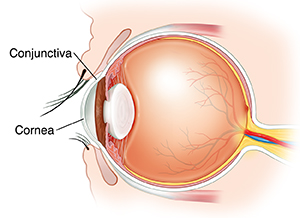Foreign Bodies in the Eye in Children
What are foreign bodies?
A foreign body in the eye is any object that isn’t supposed to be there. The foreign object may be in the conjunctiva. This is a thin membrane that covers the inside of the eyelids and the white of the eye. Or it may be in the cornea. This is the clear, dome-shaped surface that covers the colored part of the eye and the pupil.

What foreign bodies are commonly found in the eye in a child?
The most common foreign bodies in the eye include:
-
Dust
-
Dirt
-
Misplaced contact lenses
-
Sand
-
Makeup
-
Pieces of metal or rust
-
Parts of plants
What are the symptoms of foreign bodies in the eye in a child?
Symptoms can happen a bit differently in each child. They may include:
The symptoms of foreign bodies in the eye may look like symptoms of other eye issues or health problems. Make sure your child sees their healthcare provider for a diagnosis.
How is a foreign body in the eye diagnosed in a child?
Your child’s healthcare provider will ask about your child’s health history. Your child will also have an eye exam. Your child may get local numbing (anesthetic) eye drops for the exam.
Your child’s healthcare provider may also perform a fluorescein stain. This test can tell if there is an abrasion in your child’s cornea. For this test, your child’s healthcare provider will place a special paper strip with a small amount of a dye into your child's eye. This won’t hurt your child. Then, your child’s provider will use a special light to look at the surface of the cornea to look for an abrasion or scratch.
How is a foreign body in the eye treated in a child?
Treatment will depend on your child’s symptoms, age, and general health. It will also depend on how severe the condition is.
Removal of the foreign body
If your child’s healthcare provider sees a foreign body, they may remove it. A small cotton applicator may be used. Or the provider may wash your child’s eye out with a saline solution.
Medicine
The provider may put an antibiotic ointment in your child's eye. Or they may prescribe antibiotic drops for you to use at home for the next few days.
Evaluation by an eye care provider
If your child’s healthcare provider can’t remove the foreign body, if there is a severe abrasion of the cornea, if there is a possibility that a foreign body passed into the inside of the eye, or if your child is in a lot of pain, your child may need to see a specialist called an ophthalmologist. These are healthcare providers with special training to treat eye problems.
An eye patch
In general, patches are no longer used for eye injuries. If your child is old enough to tolerate patch, and there is a large abrasion on the cornea, your child's healthcare provider may advise a patch for 12 to 24 hours to make your child more comfortable.
Tetanus shot
Your child may need a tetanus shot after the foreign body is taken out. This depends on what the foreign body was. It also depends on the vaccines your child has already had.
Your child will need follow-up care with their healthcare provider after the foreign body is removed.
Key points about a foreign body in the eye in children
-
A foreign body means any object in your child’s eye that isn’t supposed to be there.
-
Common foreign bodies in the eye include dirt, dust, makeup, and pieces of metal or rust.
-
If your child’s healthcare provider sees a foreign body, they may remove it with a small cotton applicator or saline.
-
If your child’s healthcare provider can’t remove the foreign body, if there is a large abrasion on the cornea, if there is a possibility that a foreign body passed into the inside of the eye, or if your child is in a lot of pain, your child may need to see an ophthalmologist. This is an eye healthcare specialist.
-
Your child will need follow-up care with their healthcare provider after the foreign body is taken out.
Next steps
Tips to help you get the most from a visit to your child’s healthcare provider:
-
Know the reason for the visit and what you want to happen.
-
Before your visit, write down questions you want answered.
-
At the visit, write down the name of a new diagnosis, and any new medicines, treatments, or tests. Also write down any new instructions your provider gives you for your child.
-
Know why a new medicine or treatment is prescribed and how it will help your child. Also know what the side effects are.
-
Ask if your child’s condition can be treated in other ways.
-
Know why a test or procedure is recommended and what the results could mean.
-
Know what to expect if your child does not take the medicine or have the test or procedure.
-
If your child has a follow-up appointment, write down the date, time, and purpose for that visit.
-
Know how you can contact your child’s healthcare provider after office hours. This is important if your child becomes ill and you have questions or need advice.
Online Medical Reviewer:
Liora C Adler MD
Online Medical Reviewer:
Raymond Kent Turley BSN MSN RN
Online Medical Reviewer:
Ronald Karlin MD
Date Last Reviewed:
6/1/2023
© 2000-2025 The StayWell Company, LLC. All rights reserved. This information is not intended as a substitute for professional medical care. Always follow your healthcare professional's instructions.